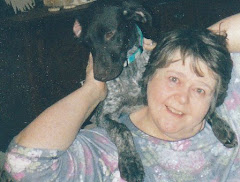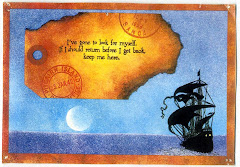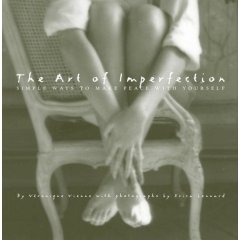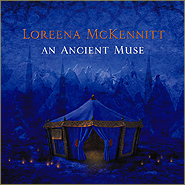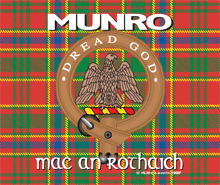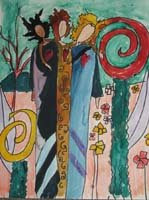"ALL HALLOW'S EVE", Artist Unknown
The first time I knew there was something more to October 31st than trick or treating and Jack O'Lanterns, ghosts and witches, was when I was a teenager. I was reading the first chapters of Thomas Hardy's "The Return of the Native", wherein the residents of England's Egdon Heath celebrated the night with giant bonfires built on hilltops. It is there, after the revelers leave, that we meet Eustacia Vye, standing alone but utterly unafraid on the hilltop as the fires die down. It was a very evocative passage, and I've never forgotten it.
About 20 years ago, I really became interested in vintage Halloween items, in particular, vintage Halloween postcards. From studying about them, I learned ancient traditions and customs as practiced by Scottish and Irish peoples - for they are the ones who brought Halloween to America.
A couple of years ago, I started learning about the Celtic culture in earnest, and learned that these Irish and Scottish customs were vestiges of ancient Celtic Halloween, or Samhain, pronounced SOW-en or SOW-in, from the Old Irish language. The word means "summer's end", the end of the light half of the year and the beginning of the dark half.
"SAMHAIN/HECATE" by Wendy Andrews
(Samhain is the time of year when
Hecate, the crone, is ascendant.)
The more I read, the more I learned that the Romans, the Catholic Church and commercialized modern society reinvented this holiday for their own purposes. But traces of Halloween's ancestral past remains tucked inside the modern celebrations.
For Celts, Samhain was one of the two most important days of the Celtic year. It marked the beginning of winter, which they celebrated as their new year, November 1st being their New Year's Day. As with all Celtic holidays, the eve before is when the celebrations took place, because the Celtic "day" began at night.
It was a liminal time, when the laws of time and space are temporarily suspended. It was said that during Samhain, the veil between this world and the afterlife was especially thin or lifted entirely. The Celts felt that during this time they were privy to supernatural and otherworldly knowledge. It was a world filled with the forces of magic, a night of mystical glory. It was referred to as "Time Which Is No Time". It was very magical, but also very dangerous.
Artist Unknown
The crow is the symbol of Samhain
An important part of Samhain was the lighting of giant bonfires on hilltops. These bonfires were full of symbolism. They gave the Celts a festive feeling and a sense of warmth, both literally and figuratively. Bonfires were wonderful gathering places for storytelling, chanting and singing, and it was considered good luck to jump over the bonfire as it died down. Hilltop fires also mirrored the light, warmth and color of the sun in the sky.
Family hearth fires were extinguished, then re-lit from the sacred communal fires. These huge bonfires were thought to consume all the miseries of the past year. They were also used to secure a promise from the sun god not to disappear altogether during the cold months ahead. The Celts hoped that the tall bonfires would rise high enough to reach the tired sun, fully rejuvenating him.
In England and Scotland, Samhain or Oiche Shamhna marked the final harvest of the year, and it was a time for herding the cattle from their summer pastures. Sometimes two bonfires would be built close together and people would drive their cows and other livestock between the fires as a cleansing ritual for all.
Samhain was also celebrated as the Feast of the Dead (much like the Mexican Day of the Dead). The Celts believed that on Samhain the spirits of their ancestors who had passed were set free to once again roam the earth. Families opened east windows or doors to specially invite their dearly departed. They laid out feasts to welcome the spirits and gain their favor. Places were set at the table for them and food and wine were offered so that they could refresh themselves after their long journey from the netherworld. Apples were buried along roadsides and paths for spirits who were lost or had no descendants to provide for them. Sweets were also set out to appease wandering spirits.
To protect themselves from mischevious spirits, the Celts would dress in frightening disguises so that the spirits would mistake them for one of their own and pass them by. They would also parade around and make loud noises to drive unwanted spirits to the edge of the community.
Predictions were more powerful on Samhain, and omens were especially clear. The Druids considered Samhain a perfect time for divination. Divination is a common folkloric practice that survived well into the late 19th and early 20th centuries. The most common uses of divination were to determine the identity of one's future spouse, one's prosperity, and how many children a person might have.
"SAMHAIN" by Jenimal
Seasonal foods such as apples and nuts were often employed in these rituals. Apples were peeled, the peel tossed over the shoulder, and its shape examined to see if it formed the first letter of the future spouse's name. I certainly remember playing that game as a child (not just on Halloween but whenever apples were peeled.) Bobbing - or dookin' - for apples on Halloween is a Scottish marriage divination. The first person to bite an apple would be the first to marry in the coming year. Dookin' for apples is thought to have originated from a Druidical rite associated with water.
Apples were used for divination in several other ways. A young girl was to go by candlelight alone to a mirror and eat an apple before it, whilst combing her hair. She would then see her future love in the glass over her shoulder. A girl would also stick apple pips to the outside of her cheek, with each one standing for her sweethearts. The last pip that stayed stuck was her true love.
Nuts were roasted on the hearth and their movements interpreted - if the nuts stayed together, so would the couple. Egg whites were dropped in a glass of water, and the shapes foretold the number of future children. Children would also chase crows and divine some of these things from how many birds appeared or the direction the birds flew.
In Scotland and Ireland, blindfolded girls would go to the garden on Samhain to pull cabbages and other vegetables to divine the physical characteristics of their future spouses by the appearance of the roots. If the roots had lots of earth clinging to them, then their spouse would be rich. If they later ate the cabbage it would reveal their future love's character - bitter or sweet!
"HALLOWEEN" by Jack Burton
Traveling after dark, especially alone, was not advised on Samhain, for this was a night of magic and chaos. The Wee Folke became very active at night, pulling pranks on unsuspecting humans. Travelers carried turnips that had been hollowed out, carved, and lit with a candle to look like a protective spirit. (In America, pumpkins were substituted for the turnips, and thus we got the Jack O'Lantern).
In Scotland, people would go to a stream on Samhain and - with closed eyes - take from the water three stones between middle finger and thumb, chanting as each was gathered. They would then carry the stones home carefully and place them under their pillows. That night, they would ask for a dream that would give them guidance or a solution to a problem, and the stones would bring it for them.
In Ireland a popular Halloween game was to have a blindfolded person sit at a table on which were placed several saucers. After the saucers had been shuffled about, the person would choose one by touch. The contents of the saucer foretold the person's fate for the following year: water meant the person would travel, a coin or salt indicated future wealth, earth/clay meant someone known to the player would die next year, a bean predicted poverty and a ring meant marriage.
"ALL SOULS NIGHT" by Leanne Peters
As with so many other Celtic holidays (Yule-Christmas, Ostara-Easter, Lughnasadha-Lammas), the Catholic church borrowed heavily from Samhain. The once purely Gaelic festival became associated with the Christian All Saints' Day, November 1, and All Souls' Day, November 2 (the word Halloween derives from All Hallow's Eve), and has influenced the secular customs now connected with Halloween. It continues to be celebrated as a religious festival by some Neopagans and Wiccans.
Though I'm neither witch nor wiccan, and I wouldn't know what to put in a cauldron besides soup, I like to think of this day not as Halloween, but as Samhain. Tonight, on this Oiche Shamhna, after the trick or treaters are all tucked in bed, I will go out to the trees at the back of our lot and gaze at the nearly full moon. I will take time to honor my dearly departed, and I will stand quietly to see if I can sense the otherworldliness of this night that my Celtic ancestors once felt so keenly.
"WHISPERING YOUR NAME -
SAMHAIN" by Amy Pixel
~~~~~~~~~~~~~~~~~~~~~~~~~~~~~~~~~~~~~~~~~
If old Halloween customs are intriguing to you, these are links to a couple of posts I wrote in October 2007:
~~~~~~~~~~~~~~~~~~~~~~~~~~~~~~~~~~~~~~~~~~~~
ADDED LATER: Leanne over at Somerset Seasons/Dorset Days (http://www.somersetseasons.blogspot.com/) has written a couple of wonderful posts about Halloween/Samhain. Her post for today is about Halloween Folklore. It includes some of the customs that I wrote about, and more that I did not know about/have room for. In yesterday's post she printed three poems to honor our ancestors on Samhain. I am going to recite the second one when I go out this evening.












































